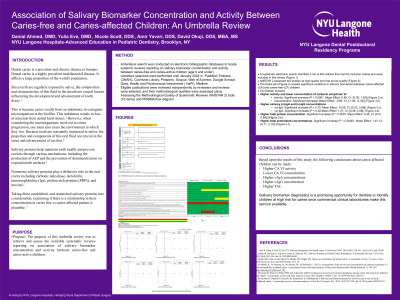Caries
177 - Association of Salivary Biomarker Concentration and Activity Between Caries-free and Caries-affected Children: An Umbrella Review


Danial Ahmed, DMD
Pediatric Dental Resident - PGY2
NYU Langone Dental Medicine, Brooklyn, NY
Salisbury, Maryland, United States- NS
Nicole Scott, DMD
NYU Langone Health
- YE
Yulia Eve, DMD
Pediatric Dental Resident
NYU Langone Health
NYU Langone - DO
David M. Okuji, Senior Associate Director, Extramural & Special Projects Advanced Education in Pediatric Dentistry
Senior Associate Director
NYU Langone Dental Medicine, Brooklyn, NY
New York, New York, United States - DK
Daniel J. Kane, DMD
Program Director
NYU Langone Health
Brooklyn, New York, United States
Presenting Author(s)
Co-Author(s)
Research Mentor(s)
Program Director(s)
Purpose: The purpose of this umbrella review is to retrieve and assess the available systematic reviews reporting on the association of salivary biomarker concentration and activity between caries-free (CF) and caries-affected (CA) children.
Methods: A literature search was conducted on electronic bibliographic databases to locate systemic reviews reporting on salivary biomarker concentration and activity between caries-free and caries-affected children. Literature searches were performed until January 2024 in PubMed, Embase, CINAHL, Cochrane Library, Prospero, Scopus, Web of Science, Google Scholar, Doss, Health and Psychosocial Instruments (HaPI), Medline. Eligible publications were reviewed independently by reviewers and reviews were selected, and their methodological qualities were assessed using Assessing the Methodological Quality of Systematic Reviews (AMSTAR 2) tools.
Results: Four hundred and ninety-three articles for possible inclusion were identified, and three studies were finally selected for qualitive analysis. With the quality assessments ranging from low to high. The included studies reported on association of Carbonic anhydrase (CA) VI activity and concentration, Salivary (s)-IgA and (s)- IgG concentration, total protein concentration, total antioxidant concentration (TAC) and activity between caries-free and caries affected children.
Conclusion: Caries-affected children had higher activity and lower concentration CA VI; and higher s-IgA, s-IgG, total protein, and TAC levels. Salivary biomarker diagnostics is a promising opportunity for dentists to identify children at high risk for caries once commercial clinical laboratories make this service available.
Identify Supporting Agency and Grant Number:

.jpg)